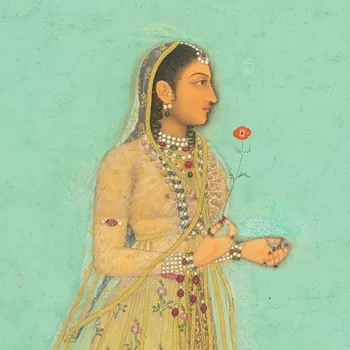The Padshahnamah frontispiece: Shah-Jahan c. 1650 - 1657
Painting in opaque watercolour including metallic paints. | 46.0 x 26.3 cm (panel) | RCIN 1005025.e
-
Padshahnamah fol. 3r
(plate 4)
A portrait of Emperor Shah-Jahan enthroned.The emperor is depicted as an elderly man with a long white beard holding prayer beads. The golden throne and footstool are similar in design to the Mughal throne in the Topkapi Palace, said to have been taken from Delhi by Nadir Shah and later presented by him to the Ottoman sultan.
A (now obscured) inscription above the portrait labels Shah-Jahan as his son Alamgir, which supports the suggestion that the manuscript was assembled into its current form in the 18th century.
Bibliography:
Milo Beach and Ebba Koch, King of the world : the Padshahnama, an imperial Mughal manuscript from the Royal Library, Windsor Castle, 1996
Saqib Baburi, Beyond the Akbarnamah: Padshahnamahs and Official Regnal Chronography for Shah-Jahan Padshah (r. 1037/1628-1068/1658), 2010.Provenance
Illustration from a Padshahnamah manuscript formerly in the Mughal imperial library and acquired by Asaf al-Dawlah, Nawab of Awadh, c.1780-90; presented by Saadat Ali Khan, Nawab of Awadh, to George III via Lord Teignmouth in June 1799.
-
Creator(s)
(artist)Acquirer(s)
-
Medium and techniques
Painting in opaque watercolour including metallic paints.
Measurements
46.0 x 26.3 cm (panel)
58.1 x 36.8 cm (page dimensions)
Category









